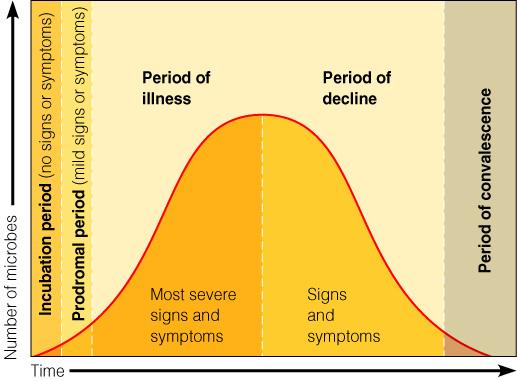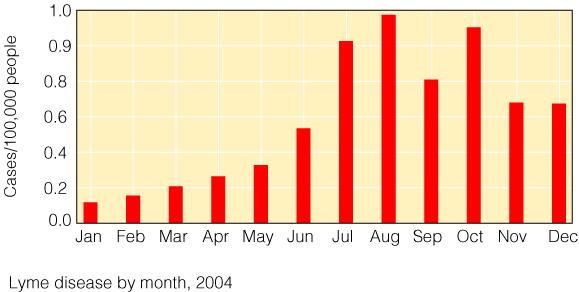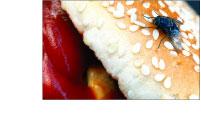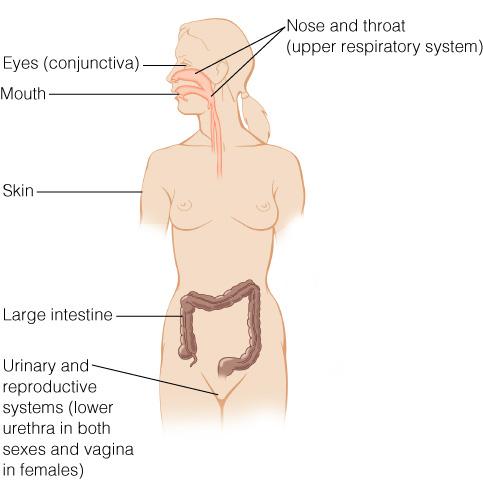PATHOLOGY, INFECTION, AND DISEASE
Pathology
The study of disease.
PATHOLOGY, INFECTION, AND DISEASE
Etiology
The study of the cause of a disease.
PATHOLOGY, INFECTION, AND DISEASE
Pathogenesis
The development of disease.
PATHOLOGY, INFECTION, AND DISEASE
Infection
Colonization of the body by pathogens.
PATHOLOGY, INFECTION, AND DISEASE
Disease
An abnormal state in which the body is not functioning normally.
NORMAL MICROBIOTA AND THE HOST
Transient microbiota
May be present for days, weeks, or months.
NORMAL MICROBIOTA AND THE HOST
Normal microbiota
Permanently colonize the host
NORMAL MICROBIOTA AND THE HOST
Symbiosis
Is the relationship between normal microbiota and the host.
SYMBIOSIS
Commensalim
One organism benefits, and the other is unaffected.
SYMBIOSIS
Mutualism
Both organisms benefit.
SYMBIOSIS
Parasitism
One organism benefits at the expense of the other.
SYMBIOSIS
Opportunistic pathogens
Some normal microbiota ordinarily do not cause disease in their normal habitat in a healthy person but may do so in a different environment.
NORMAL MICROBIOTA AND THE HOST
Microbial antagonism
Is a competition between microbes.
NORMAL MICROBIOTA AND THE HOST
Normal microbiota
PROTECT THE HOST BY:
1. Occupying niches that pathogens might occupy
2. Producing acids
3. Producing bacteriocins
NORMAL MICROBIOTA AND THE HOST
Probiotics
Live microbes applied to or ingested in the body, intended to exert a beneficial effect.
KOCH'S POSTULATES
1. The same pathogen must be present in every case
of the disease.
2. The pathogen must be isolated from the diseased
host and grown in pure culture.
3. The pathogen from the pure culture must cause
the disease when it is inoculated into a
healthy, susceptible laboratory animal.
4. The pathogen must be isolated from the
inoculated animal and must be shown to be the
original organism.
KOCH'S POSTULATES: UNDERSTANDING DISEASE
Figure 14.3
1. Microorganisms are isolated from a diseased or
dead animal.
2a. The microorganism are grown in pure culture.
2b. The microorganisms are identified.
3. The microorganisms are injected into a healthy
laboratory animal.
4. Disease is reproduced in a laboratory animal.
5a. The microorganisms are isolated from this
animal and grown in a pure culture.
5b. Microorganisms are identified.
**Microorganisms in the diseased host caused the same disease in a laboratory host**
KOCH'S POSTULATES
Koch's postulates are used to prove the cause
of infectious disease:
a. Some pathogens can cause several disease
conditions.
b. Some pathogens cause disease only in humans.
CLASSIFYING INFECTIOUS DISEASES
Symptom
A change in body function that is felt by a patient as a result of disease.
CLASSIFYING INFECTIOUS DISEASES
Sign
A change in body that can be measured or observed as a result of disease.
CLASSIFYING INFECTIOUS DISEASES
Syndrome
A specific group of signs and symptoms that accompany a disease.
CLASSIFYING INFECTIOUS DISEASES
Communicable disease
A disease that is spread from one host to another.
CLASSIFYING INFECTIOUS DISEASES
Contagious disease
A disease that is EASILY spread from one host to another.
CLASSIFYING INFECTIOUS DISEASES
Non-communicable disease
A disease that is not transmitted from one host to another.
OCCURENCE OF A DISEASE
Incidence
Fraction of a population that CONTRACTS A DISEASE during a specific time.
OCCURENCE OF A DISEASE
Prevalence
Fraction of a population HAVING A SPECIFIC DISEASE at a given time.
OCCURENCE OF A DISEASE
Sporadic disease
Disease that occurs occasionally in a population.
OCCURENCE OF A DISEASE
Endemic disease
Disease constantly present in a population.
OCCURENCE OF A DISEASE
Epidemic disease
Disease acquired by many hosts in a given area in a short time.
OCCURENCE OF A DISEASE
Pandemic disease
Worldwide epidemic.
OCCURENCE OF A DISEASE
Herd immunity
Immunity in most of a population.
SEVERITY or DURATION OF A DISEASE
Acute disease
Symptoms develop rapidly.
SEVERITY or DURATION OF A DISEASE
Chronic disease
Disease develops slowly.
SEVERITY or DURATION OF A DISEASE
Subacute disease
Symptoms are between acute and chronic.
SEVERITY or DURATION OF A DISEASE
Latent disease
Disease with a period of no symptoms when the causative agent is inactive.
EXTENT OF HOST INVOLVEMENT
Local infection
Pathogens are limited to a small area of the body.
EXTENT OF HOST INVOLVEMENT
Systemic infection
An infection throughout the body.
EXTENT OF HOST INVOLVEMENT
Focal infection
Systemic infection that began as a local infection.
EXTENT OF HOST INVOLVEMENT
Sepsis
Toxic inflammatory condition arising from the spread of microbes, especially bacteria or their toxins, from a focus of infection.
EXTENT OF HOST INVOLVEMENT
Bacteremia
Bacteria in the blood.
EXTENT OF HOST INVOLVEMENT
Septicemia
Growth of bacteria in the blood.
EXTENT OF HOST INVOLVEMENT
Toxemia
Toxins in the blood.
EXTENT OF HOST INVOLVEMENT
Viremia
Viruses in the blood.
EXTENT OF HOST INVOLVEMENT
Primary infection
Acute infection that causes the initial illness.
EXTENT OF HOST INVOLVEMENT
Secondary infection
Opportunistic infection after a primary (predisposing) infection.
EXTENT OF HOST INVOLVEMENT
Subclinical disease
No noticeable signs or symptoms (inapparent infection).
PREDISPOSING FACTORS
MAKE THE BODY MORE SUSCEPTIBLE TO DISEASE:
a. Short urethra in females
b. Inherited traits, such as the sickle cell gene
c. Climate and weather
d. Fatigue
e. Age
f. Lifestyle
g. Chemotherapy
RESERVOIRS OF INFECTION
CONTINUAL SOURCES OF INFECTION:
a. HUMAN: AIDS, GONORRHEA
- CARRIERS may have inapparent infections or
latent diseases.
b. ANIMAL: RABIES, LYME DISEASE
- Some ZOONOSES may be transmitted to humans.
c. NONLIVING: BOTULISM, TETANUS
- Soil.
TRANSMISSION OF DISEASES
CONTACT:
a. DIRECT: requires close association between
infected and susceptible host.
b. INDIRECT: spread by FOMITES-a nonliving object
that can spread infection.
c. DROPLET: transmission via airborne droplets.
VEHICLE TRANSMISSION
Transmission by an inanimate reservoir (food, water, air).
VECTORS
1. Arthropods, especially fleas, ticks, and
mosquitoes.
2. TRANSMIT DISEASE BY TWO GENERAL METHODS:
a. MECHANICAL TRANSMISSION: arthropod carries
pathogen on feet.
b. BIOLOGICAL TRANSMISSION: pathogen reproduces
in vector.
NOSOCOMIAL INFECTIONS
1. Are acquired as a result of a hospital stay.
2. Affect 5-15% of all hospital patients.
**Prevent direct contact transmission through the use of gloves, masks, and face shields.
NOSOCOMIAL INFECTIONS
Figure 14.9
1. Microorganisms in hospital environments.
2. Compromised host (or weakened) status of the
host.
3. Chain of transmission in the hospital.
***THE PRESENCE OF ANY ONE OF THESE FACTORS ALONE IS GENERALLY NOT ENOUGH TO CAUSE INFECTION; IT IS THE INFRACTION OF ALL THREE FACTORS THAT POSES A SIGNIFICANT RISK OF NOSOCOMIAL INFECTION.
PRINCIPLE SITES OF NOSOCOMIAL INFECTIONS
Table 14.5
1. URINARY TRACT INFECTIONS:
32% most common of nosocomial infections.
2. SURGICAL SITE INFECTIONS:
22% ranked second of nosocomial infections.
3. LOWER RESPIRATORY INFECTIONS:
15% pneumonias of nosocomial infections.
4. BLOODSTREAM INFECTIONS:
14% bacteremias of nosocomial infections.
5. OTHER:
17% all others sites of nosocomial infection.
COMMON CAUSES OF NOSOCOMIAL INFECTIONS
1. Coagulase-negative staphylococci: 15% of total
infections; 89% resistant to antibiotics.
2. S. aureus: 15% of total infections; 80%
resistant to antibiotics.
3. Enterococcus: 10% of total infections; 4-71%
resistant to antibiotics.
4. Gram-negative rods: 15-25% of total infections;
3-32% resistant to antibiotics.
5. C. difficile: 13% of total infections;
not reported resistant to antibiotics.
EMERGING INFECTIOUS DISEASES
Diseases that are new, increasing in incidence, or showing a potential to increase in the near future.
EMERGING INFECTIOUS DISEASES
CONTRIBUTING FACTORS:
a. Genetic recombination:
- E.coli O157, avian influenza (H5N1)
b. Evolution of new strains:
- V. cholera O139
c. Inappropriate use of antibiotics and pesticides:
- Antibiotic-resistant strains
d. Changes in weather patterns:
- Hantavirus
e. Modern transportation:
- West Nile virus
f. Ecological disaster, war, and expanding human
settlement:
- Coccidioidomycosis
g. Animal control measures
- Lyme disease
h. Public health failure:
- Diphtheria
EPIDEMIOLOGY
1. The study of where and when diseases occur.
2. CENTERS FOR DISEASE CONTROL AND PREVENTION
(CDC):
a. Collects and analyzes epidemiological
information in the United States.
b. Publishes MORBIDITY AND MORTALITY WEEKLY
REPORT (MMWR).
c. www.cdc.gov
EPIDEMIOLOGY
1. John Snow (1848-1849)- mapped the occurrence of
cholera in London.
2. Ignaz Semmelweis (1846-1848)- showed that hand
washing decreased the incidence of puerperal
fever.
3. Florence Nightingale (1858)- showed that
improved sanitation decreased the incidence
of epidemic typhus.
EPIDEMIOLOGY
Case reporting
Healthcare workers report specified disease to local, state, and national offices.
EPIDEMIOLOGY
Nationally notifiable diseases
Physicians are required to report occurrence.
THE CDC
Morbidity
Incidence of a specific notifiable disease.
THE CDC
Mortality
Deaths from notifiable diseases.
THE CDC
Morbidity rate
Number of people affected in relation to the total population in a given time period.
THE CDC
Mortality rate
Number of deaths from a disease in relation to the population at a given time.
The term best associated with the cause of disease is:
A) infection.
B) etiology.
C) pathogen.
D) pathogenesis.
E) parasitism.
Etiology
In a healthy human, resident microorganisms would be found in all of the following areas except:
A) bloodstream.
B) tooth and gum surfaces.
C) lower urethra.
D) nasal passages.
E) conjunctiva.
Bloodstream
Healthcare professionals who fail to use aseptic techniques can cause:
A) Predisposing factors.
B) Zoonoses.
C) Nosocomial infections.
D) Herd immunity.
E) Pathogens.
Nosocomial infections
In the human intestinal tract, E. coli produces vitamins beneficial to the host and can inhibit pathogen growth. In turn, the bacterium is supplied with nutrients and an environment for growth. This symbiotic relationship between E. coli and its host is an example of:
A) opportunism.
B) mutualism.
C) antagonism.
D) parasitism.
E) commensalism.
Mutualism
Which of the following is not an example of microbial antagonism?
A) Microbes competing with other microbes for
nutrients.
B) Microbes utilizing oxygen necessary for the
growth of other microbes.
C) Microbes producing acidic compounds that limit
the growth of many bacteria.
D) Microbes producing vitamins and growth factors
that can be utilized by the host.
E) Microbes producing compounds inhibitory to
other microbes.
Microbes producing vitamins and growth factors that can be utilized by the host.
An infection transmitted by a hypodermic needle is transmitted by:
A) Indirect contact.
B) Droplet transmission.
C) Common vehicle transmission.
D) Direct contact.
E) A vector.
Indirect contact
Which of the following is not necessary to satisfy Koch's postulates?
A) The organism must cause disease through toxin
production.
B) The organism must cause the disease when
introduced from pure culture into a healthy
host.
C) The organism must be re-isolated from the
experimentally infected diseased animal and
shown to be identical to the original isolate.
D) The organism must be grown in pure culture
outside the diseased host.
E) The organism must be present in every case of
the disease.
The organism must cause disease through toxin production.
Infectious diseases which are easily passed from host to host within a population are best described as:
A) acute.
B) noncommunicable.
C) chronic.
D) communicable.
E) contagious.
Contagious
An epidemic disease of worldwide proportions would best be described as:
A) chronic.
B) sporadic.
C) pandemic.
D) acute.
E) endemic.
Pandemic
The occurrence of streptococcal bronchopneumonia in an individual recovering from influenza is an example of a/an:
A) subacute infection.
B) secondary infection.
C) latent infection.
D) sporadic infection.
E) chronic infection.
Secondary infection
Infections in which the pathogen is distributed throughout the body are referred to as "generalized infections" or:
A) emerging infections.
B) local infections.
C) focal infections.
D) systemic infections.
E) zoonoses.
Systemic infections
In a patient with bacteremia, you would expect to find:
A) bacteria in a localized area, such as an
abscess.
B) bacteria in the blood.
C) viruses in the blood.
D) an increase in bacteria in the blood and
localized areas over time .
E) bacterial toxins in the blood.
Bacteria in the blood.
Which of the following diseases does not have a human reservoir?
A) AIDS
B) gonorrhea
C) tetanus
D) Strep infections
E) diphtheria
Tetanus
Which if the following is an example of contact transmission?
A) A person drinks from a cup used by another
individual.
B) A person develops plague from a flea bite.
C) Tuberculosis is spread from one person to
another after traveling through the air for
several meters.
D) Several people become infected with Listeria
after consuming contaminated ice cream.
E) Vacationers develop shigellosis, caused by the
intestinal pathogen Shigella sp., after
drinking contaminated water.
A person drinks from a cup used by another individual.
Vector transmission is not responsible for:
A) Lyme disease.
B) dengue.
C) influenza.
D) malaria.
E) Rocky Mountain Spotted Fever.
Influenza
Any of the following may occur in diseases transmitted by vectors except:
A) In biological transmission, vectors can
spread pathogens by vomiting.
B) In biological transmission, the vector
multiplies in the human host.
C) In biological transmission, a vector transmits
pathogens by defecating while taking a blood
meal.
D) In biological transmission, pathogens multiply
in the vector, which can transmit the pathogens
by injecting saliva directly into the host.
E) In mechanical transmission, insects contact
feces containing pathogenic bacteria and
transfer it to food.
In biological transmission, the vector multiplies in the human host.
Which of the following is the third stage of a disease?
A) period of decline
B) period of illness
C) incubation period
D) period of convalescence
E) prodromal period
Period of illness.
The morbidity rate is best defined as:
A) the percentage of infectious diseases that are
nationally notifiable.
B) the number of individuals, relative to the
population, affected by a particular disease in
a period of time.
C) the immunization rate for notifiable diseases
that can be prevented through vaccination
programs.
D) the number of individuals, relative to the
population, who have died as a result of a
particular disease in a period of time.
E) the decrease in death rate following effective
vaccination.
The number of individuals, relative to the population, affected by a particular disease in a period of time.
The ingestion of lactic acid bacteria for the purpose of preventing colonization by intestinal pathogens such as Salmonella enterica during antibiotic therapy is an example of:
A) parasitism.
B) chemotherapy.
C) probiotics.
D) vaccination.
E) opportunism.
Probiotics
An example of descriptive epidemiology is:
A) John Snow's study of the London cholera
outbreak in 1848-1849.
B) The first report of a disease occurrence.
C) Comparison of drug effectiveness in two groups
of patients.
D) Florence Nightingale's studies of disease
transmission in soldiers and civilians during
the Crimean War.
E) A study comparing disease rates in vaccinated
and non-vaccinated individuals.
John Snow's study of the London cholera outbreak in 1848-1849.
Most microorganisms are pathogenic and harmful to the human body.
A) True
B) False
False
It is possible for a host to harbor a pathogen without development of disease.
A) True
B) False
True
Disease symptoms are readily measured by health-care professionals.
A) True
B) False
False
Tetanus, which humans acquire from wounds that become infected with the soil microbe Clostridium tetani, is considered noncommunicable.
A) True
B) False
True
Transmission of Salmonella through contaminated chicken salad at a family picnic is an example of vector transmission.
A) True
B) False
False
Water can serve as a human reservoir of Vibrio cholerae.
A) True
B) False
False
In biological transmission, pathogens reproduce in the vector.
A) True
B) False
True
A nosocomial infection is one that develops as a result of a stay in a health-care facility.
A) True
B) False
True
Depending on the disease, individuals can be contagious during the incubation period, prodromal period, period of illness, period of decline, and period of convalescence.
A) True
B) False
True
For the case control method in analytical epidemiology, a group of individuals with the disease is compared to matched controls.
A) True
B) False
True

Michael woke up feeling suddenly like he was getting a sore throat and a headache. Which stage of a disease's progression is he most likely in?
A) Convalescence period
B) Prodromal period
C) Illness period
D) Incubation period
E) Decline period
Prodromal period

Tim ate raw oysters at a local restaurant and has since discovered he contracted hepatitis A. Which mode of transmission is this?
A) Vehicle transmission
B) Droplet transmission
C) Direct contact
D) Mechanical transmission
E) Airborne transmission
Vehicle transmission

Which month is the number of cases of Lyme disease the greatest?
A) July
B) December
C) August
D) January
August

Houseflies can transfer the pathogens of typhoid fever from the feces of infected people to food. This is an example of ____________ transmission.
A) Mechanical
B) Direct contact
C) Indirect contact
D) Droplet
E) Vehicle
Mechanical

The figure shows the locations of normal microbiota on and in the human body. Which of these locations has the largest numbers of resident microbiota?
A) Nose and throat
B) Reproductive systems
C) Large intestine
D) Mouth
E) Skin
Large intestine
Following coronary artery bypass surgery, seven patients develop Rhodococcus bronchialis infections. Cultures of the operating rooms, Nurse A, and Nurse B are taken. R. bronchialis grows from the hand and nasal swabs of Nurse A. The patients' infections are an example of a(n):
A) nosocomial infection.
B) emerging infectious disease.
C) communicable disease.
D) sporadic infection.
Nosocomial infection
All members of the seven families for whom Mary Mallon prepared meals developed typhoid fever. Mary did not get sick. This is an example of a(n):
A) nosocomial infection.
B) sporadic disease.
C) emerging disease.
D) carrier state.
Carrier state
The difference between normal and transient microbiota is that normal microbiota:
A) are permanently present.
B) are on the human body.
C) cause disease.
D) are opportunistic pathogens.
Are permanently present.
Robert Koch demonstrated that infectious disease:
A) all of the above.
B) is acquired by contact with an infected
person.
C) is transmitted by direct contact.
D) is caused by a microbe growing in the body.
Is caused by a microbe growing in the body.
A disease that is constantly present in a population is called a(n):
A) notifiable disease.
B) endemic disease.
C) communicable disease.
D) epidemic disease.
Endemic disease
Emergence of infectious disease can be due to all of the following reasons. Which one can be affected by changing human behavior?
A) floods
B) earthquakes
C) mutations in microbes
E) lack of vaccination
Lack of vaccination
Two patients developed endophthalmitis within 24 hours after corneal transplant surgery. The corneas have been stored in buffered media with gentamicin. Each patient had received a subconjunctival injection of gentamicin after transplantation. Streptococcus pneumoniae was isolated from conjunctival swabs of the affected eyes of both patients and from donor corneoscleral tissue. The post-transplant infections could have been prevented by:
A) the surgeon washing her hands.
B) avoiding donors who have infectious diseases.
C) aseptic techniques during surgery.
D) antimicrobial susceptibility testing of the
bacteria before surgery.
Antimicrobial susceptibility testing of the bacteria before surgery.
On October 29, Barbara participated in a study group for her Microbiology class. On November 1, Barbara had a "scratchy throat" when she swallowed. On November 2, Barbara had a headache, runny nose, and watery eyes. She was fully recovered on November 7. Identify the prodromal period for this infection.
A) Nov. 1
B) Nov. 2
C) Oct. 29-Nov. 1
D) Nov. 2-7
Nov. 1
John Snow analyzed information on cholera victims. This is an example of:
A) descriptive epidemiology.
B) case reporting.
C) controlled experimentation.
D) analytical epidemiology.
Descriptive epidemiology
Florence Nightingale compared disease statistics for soldiers before and after use of sanitation measures. This is an example of:
A) controlled experimentation.
B) descriptive epidemiology.
C) analytical epidemiology.
D) case reporting.
Analytical epidemiology
Ehrlichiosis is transmitted by Ixodes scapularis ticks. This is an example of:
A) vehicle transmission.
B) indirect contact.
C) airborne transmission.
D) arthropod vector transmission.
Arthropod vector transmission
Toxoplasmosis is transmitted to humans by cats. This is an example of:
A) direct contact.
B) vehicle transmission.
C) airborne transmission.
D) indirect contact.
Direct contact
The fungus Coccidioides immitis is found in the soil. Humans contract coccidioidomycosis by inhaling fungal spores. The reservoir for this disease is:
A) soil.
B) human.
C) animals.
D) air.
Soil
Which one of the following does not belong with the others?
A) Hantavirus
B) Brucella
C) Measles
D) Yersinia pestis
Measles
Which one of the following diseases is noncommunicable?
A) botulism
B) influenza
C) streptococcal sore throat
D) rabies
Botulism
A continual source of infection is called a:
A) carrier.
B) reservoir.
C) predisposing factor.
D) common vehicle.
Reservoir
An infection that does not cause any signs of disease is a(n):
A) secondary infection.
B) inapparent infection.
C) endemic infection.
D) sporadic infection.
Inapparent infection
Alfalfa sprouts were responsible for transmitting Salmonella to 32 people in four states. This is an example of:
A) droplet transmission.
B) indirect contact transmission.
C) vehicle transmission.
D) contact transmission.
Vehicle transmission
Two patients developed endophthalmitis within 24 hours after corneal transplant surgery. The corneas had been stored in buffered media with gentamicin. Each patient had received a subconjunctival injection of gentamicin after transplantation. Streptococcus pneumoniae was isolated from conjunctival swabs of the affected eyes of both patients and from donor corneoscleral tissue. This is an example of:
A) transmission by a fomite.
B) vehicle transmission.
C) a nosocomial infection.
D) contact transmission.
A nosocomial infection
On October 29, Barbara participated in a study group for her Microbiology class. On November 1, Barbara had a "scratchy throat" when she swallowed. On November 2, Barbara had a headache, runny nose, and watery eyes. She was fully recovered on November 7. Identify the incubation period for this infection.
A) Oct. 29-Nov. 1
B) Nov. 2-7
C) Nov. 1
D) Oct. 30
Oct. 29-Nov. 1